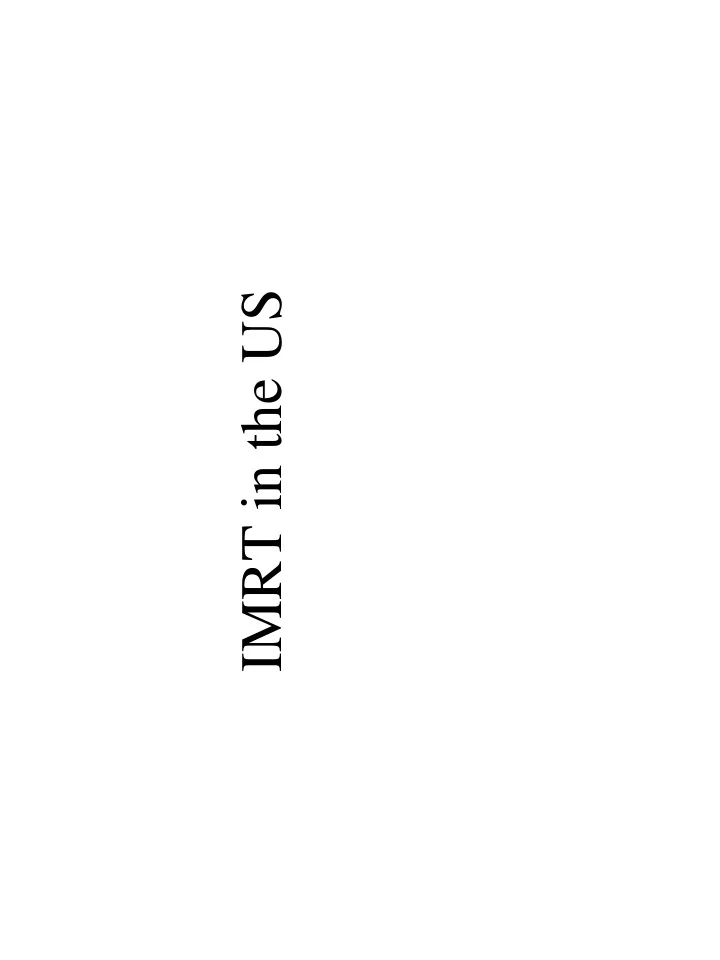

IMRT in the US
IMRT in the US • Mell LK, Mehrotra AK, Mundt AJ . Cancer, 104:1296, 2005 • Random sample US radiation oncologists, Summer ‘04 • 368 evaluable physicians; 239 (65%) responded • IMRT usage – 2002 32% – 2004 73% • Major reasons cited for IMRT adoption – normal tissue sparing 88% – dose escalation 85% – economic competition 62% • Nonusers: 91% “planned to adopt IMRT in the future” – The future is now in the US • Jan 2009: ASTRO and ACR Practice Guidelines for IMRT, IJROBP
My guess close to 73% 100% Approximate % Centers With IMRT Usage in US 32% 2002 2004 2006 2008 Year 2002 and 2004 data from Mell LK, Mehrotra AK, Mundt AJ . Cancer, 104:1296, 2005
IMRT in the US • By site – Nearly all: Prostate, head and neck – Many: Brain, breast – Misc: • GYN vs implant • Mesothelioma, anal. Articles on almost all site • Implications – Rad Onc revenue for hospitals • Growth largely in Technical Revenue • Increases in hospital profit margin – “Physicist employment act” – “Machine inflation” • Rapid adaptation of new techniques • Competition • Patient-driven – MD: anatomy, time for segmentation – Tx times increase, longer hours, attraction of “rapid arc”
IMRT: Misconceptions • “… even with IMRT, … ‘perfect’ plan that creates completely homogeneous coverage of the target volume and zero or small dose to the adjacent organs at risk is not always obtained.” (my emphasis) • Hatano, Int J Clin Oncol. 12(6):408, 2007.
IMRT: Misconceptions • “… even with IMRT, … ‘perfect’ plan that creates completely homogeneous coverage of the target volume and zero or small dose to the adjacent organs at risk is not always obtained.” (my emphasis) never • Hatano, Int J Clin Oncol. 12(6):408, 2007.
Framing the Debate • “Anti IMRT” • “Pro” IMRT – The allegation – The response • Usually too complex • Why not, it is “optimal” • Hard to QA • QA will get easier with practice • Non-intuitive • Intuition will come over time • Time consuming to plan, • Treatment times are declining and treat (??) • Costs will drop as volume • Expensive increases • Keep it simple • People said CT was unnecessary (“we can feel and see the tumor”) • Don’t act so old • Distraction • Who can you trust? • Can’t trust it
Against IMRT Widespread Use • 3D relies on segmented anatomy. – Human verification with port films • IMRT relies on segmented anatomy and DVH’s – No port films – DVH’s are subject to uncertainly and human error • Distraction – Move from 2D --> 3D is huge, and is far more important than all the rest (including IMRT)
CT 3D IMRT Beams Dose Contour Apertures Constraints Segment Computer Computer Not Not Magic Magic DVH O.K. O.K. Treat O.K. DVH Assess doses, O.K. beam Assess orientation & DVH’s aperture Beam orientations, “apertures,” Apply prior intensity maps not intuitive. knowledge
Brain Tumor: 2 to 6 Beams
Data from scans of patients with brain tumors 2-Beam 3-Beam 4-Beam 5-Beam 6-Beam Integral Dose Ź Ź Ź Ź Ź Average Std. Dev. 2516 2649 3011 3097 3074 2870 268 (± 9.3%) Patient 1 3507 3551 3610 3739 3708 3623 100 (± 2.8%) Patient 2 4315 4420 4723 4617 4628 4541 168 (± 3.7%) Patient 3 1581 1632 1814 1780 1770 1716 102 (± 5.9%) Patient 4 4913 4980 4998 4952 4952 4959 32 (± 0.6%) Patient 5 laterals non-coplanar beam arrangements Standard Deviations <10% Curle and Das, Duke
Prostate Cancer: 2 to 6 Beams
Data from scans of patients with prostate tumors 3-Beam 4-Beam 5-Beam 6-Beam Integral Dose Average Stan. Dev. 8226 7593 8067 8135 8005 282 (± 3.5%) Patient 1 6911 6523 6722 6858 6753 173 (± 2.6%) Patient 2 5221 4732 5035 5145 5033 215 (± 4.3%) Patient 3 5178 4796 5099 5099 5043 169 (± 3.3%) Patient 4 4449 4198 4305 4402 4339 111 (± 2.6%) Patient 5 All axial beams Standard Deviations <5% Curle and Das, Duke
Mean Lung Doses (Gy): Univ. Michigan Case 1 2 3 4 5 6 7 8 3D 20.0 10.2 12.9 18.0 12.8 16.6 10.5 9.1 conformal Same 19.8 10.5 12.2 18.4 12.6 16.6 12.5 8.3 orientation IMRT 20.0 10.6 11.8 18.0 13.4 16.7 12.6 9.1 3F IMRT 19.6 10.6 11.5 18.0 13.6 16.7 12.1 9.3 5F IMRT 20.1 10.6 12.4 18.1 11.2 16.6 11.0 8.9 7F IMRT 20 11 12 18 13 17 12 9 Average % STD Deviation 1 2 4 1 7 <1 8 4 Modified from Chapet et al. IJROBP 65:261, 2006
Increased ncreased in deviations in in deviations in “ “low tech low tech” ” txs txs: : I 0.22 Deviation Rate % 0.20 Low Tech 0.16 High Tech 0.10 0.09 0.06 0.11 3 Low Tech 1 Low Tech 1 High Tech 4 High Tech 4 High Tech Years Maintaining ‘low tech’ competency in ‘high tech’ era
Recommend
More recommend